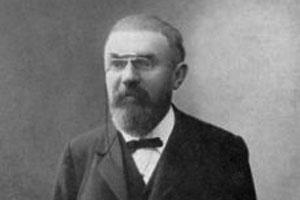French mathematician Henri Poincaré’s conjecture has profound implications for the shape of the universe.
A Matter of Numbers | Dilip D’Souza
Draw a circle on a sheet of paper. Now draw a smaller one inside it and erase the first. Draw a still smaller one and erase the second. Keep going like this, and eventually you’ll be down to a point. What you’ve done is “tighten” your original circle until you get a point.
Hold that thought and now imagine doing the same on a sphere. Draw a circle on it, then tighten it to a point in the same way. Since it’s possible to do this on both the sheet of paper and the sphere, mathematicians say these two are “simply connected”.
But let’s say I now give you a doughnut . Not to eat, but to draw circles on. Draw one that goes right around the hole in the centre. Meaning, if it was a car tyre instead, your circle would pass through “MRF” and “175/60R15” and all the other arcane lettering that disfigures the sides of tyres.

Henri Poincare (1854–1912). Photograph from the frontispiece of the 1913 edition of Last Thoughts. Courtesy Wikipedia
Can you tighten that circle to a point? No, because the hole gets in the way. (What’s another kind of circle you can draw on the doughnut that also cannot be tightened to a point?) A doughnut, therefore, is not simply connected in the way spheres or sheets of paper are. (Mathematicians say doughnuts and spheres are not “homeomorphic”).
What this means is that if your sphere was made of clay, there’s no way you could twist and shape it into a doughnut without cutting a hole in it. You could, however, twist and shape a doughnut into a coffee cup, because each of those can be considered, in essence, as a lump of material with one hole through it.
Obscure stuff? Yet this is the kind of thing some mathematicians, called topologists, work on for a living. (The famous joke about topologists is that they can’t tell a doughnut from a coffee cup. Ha ha.) In particular, the brilliant 19th century French mathematician Henri Poincaré once made this conjecture he never was able to prove (or disprove):
• Every simply connected, closed three-dimensional manifold is homeomorphic to the three-dimensional sphere.
In effect, Poincaré’s conjecture (no, not conjecturé) suggests that you can apply the “tightening” argument to certain more complicated mathematical surfaces. Fascinatingly, this has profound implications for the shape of the universe.
Trying to understand more than that much has me floundering in mathematical esoterica, so I’ll leave it there. But his conjecture was one of mathematics’ great unsolved mysteries for nearly a century after Poincaré proposed it in 1904. In 2003, a Russian mathematician called Grigori Perelman solved it, but has famously refused any recognition for his achievement, including a million-dollar prize that was on offer.
Mathematicians, what can you say.
The reason I mention all this is that this year is a century since Poincaré died. Some weeks ago, another French mathematician spoke about him at IIT-Bombay. Étienne Ghys works at one of France’s finest universities, the École Normale Supérieure in Lyon. His speech was about something mathematicians from Isaac Newton all the way to Poincaré—understandably, given his interest in topology—were obsessed with: what’s the precise shape of the earth?
Poincaré thought about what happens to a spherical mass such as the earth when it rotates. He theorized that it will flatten and elongate into a pear-shape, or really the shape of the menhirs that the comic book charmer Obelix lugs about. Imagine a menhir lying on its side and spinning: that’s what Poincaré had in mind. Ghys and some colleagues put together an elegant film that shows how this happens (look it up).
It’s a tribute to Poincaré’s brilliance that he influenced so many areas of mathematics. But there hasn’t been much work on the shape of the earth since him. As the Nobel winner S. Chandrasekhar once wrote: “The grand mental panorama that (was) created was so intoxicating that those following Poincaré were not to recover from its pursuit…the subject quietly went into a coma.”
At IIT, Ghys gave us a good idea of the kind of thinker his great compatriot was. But for this dabbler in math, Ghys brought Poincaré alive by speaking of his fascination with the importance of intuition in discovery, especially in his own research. The story goes that another of his mathematical discoveries came to him in a flash of insight and intuition as he stepped onto a bus. Which was reminiscent, of course, of another famous Frenchman, the writer Marcel Proust.
Biting once into a little biscuit known as a madeleine, Proust was overwhelmed by a host of memories and images of his childhood and he wrote some exquisite prose about that experience.
Poincaré, for his part, wrote some exquisite (I’m sure) mathematical esoterica about his experience: the theory of something called Fuchsian groups.
And for my part, the charm of dabbling in mathematics is in the way it can bring together madeleines and the shape of the earth, menhirs and coffee cups. Some of which, yes, are even simply connected.
Once a computer scientist, Dilip D’Souza now lives in Mumbai and writes for his dinners. A Matter of Numbers will explore the joy of mathematics, with occasional forays into other sciences. Comments are welcome at [email protected]

